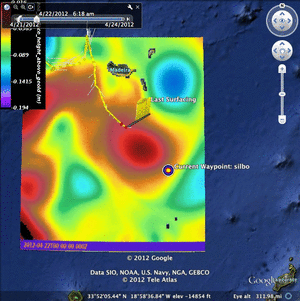Hey All!
Sorry for brief hiatus, but this past week I have been bogged down with academics; but back to the Challenger Mission.
Before we get to Silbo, I would like to officially welcome RU29 to the Challenger Family!
RU 29 is a G2 Slocum Electric Glider with an extended battery bay which when packed with Lithiums, will give us nearly 500 days of battery life at sea! 29’s goal: to fly from Cape Town, South Africa to the Ascension Islands in the middle of the Atlantic
The trip will be about 4,500 km and deployment is still being determined but we hope some point this summer.
Speaking of the summer, with the end of the semester being less than a month away, both myself and Silbo are preparing to make land fall in the Canary Islands.
Silbo is now just about 400km from the shores of Gran Canaria, with a estimated arrival date around May 15 and as long as we can avoid the heavier ship traffic as we near the Island, it looks like we should make it. The battery estimates agree with us as our calculations show that we should be good through the first week of June.
From his location, Silbo will now fly to the south east to most likely the north eastern shore of the Savage Islands (small island chain about half way between Silbo and the Canaries), continue to the ESTOC zone (29º10’N – 015º20’W) where the data collected will be added to the extensive research done in the area, and finally meet us for the celebrations on the shores of Gran Canaria in mid may.
But now back to the mission at hand: piloting silbo safely to his destination. Where we left off last week, Carlos and his team were sailing out of Madeira to deploy some drifters and we were trying to conduct a visual inspection to see if there was any significant biological growth on his exterior. However we arrived at the position well ahead of schedule and so to kill time we tried to head north of the island to try and sample an eddy, however we got trapped in a very strong northward current and resulted in us missing the rendezvous. As we kept an eye on the ship traffic, the drifters were then launched at about 32.6N, 17.4W and within a few days, Silbo caught up and passed them as he continues on his journey south.
A problem we seem to have been encountering recently has been an increase in dropped calls, or interruptions in communications when Silbo is at the surface calling in to doc server. As we passed the west coast of Madeira, Silbo came within 13km of dangerously shallow bathymetry as a call was dropped that was providing a new way point. Not only is the lack of data transport potentially disastrous due to dropped calls, but our time spent on the surface making some times multiple calls trying to reconnect to the satellites increases our chance of being struck by a ship. A very close eye will be needed on this as we get closer to the ESTOC region and the Canaries in general as the traffic increases exponentially.
As Silbo has continued on his way south, we have entered a new eddy solar system that we can see evolve in the movie below from April 22-April 28 thanks to Antonio and the Myocean Data Set.

The presence of the eddy to our south correlates very closely with how the currents recorded by silbo changed as he moved from the smaller warm eddy to the larger one we are on the cusp of at the moment. This large one is the source of the south east flow we are now encountering.
Above is an image created by Antonio showing the salinity showing that the eddy is so intense, that the effect on salinity can be seen all of the way down to 900m. This eddy will fuel our progress over the next week or so as we ride it to the south east on our way past the savage islands.
Below we see the Hycom, NCOM and Nlom data sets for today showing a different perspective as the flows are generally in the south west direction:
Now that we have made enough progress east, we are now in the domain to use a new website, MarineMet. This website will provide useful data not only for Silbo’s continued progress as long as we remain within it’s limits, but it will also be useful for 29’s mission in the up coming months.
And finally, The Challenger Mission has a new web page with tons of history, background information and interactive images for everyone to see. This new web page can be found here: http://challenger.marine.rutgers.edu/
For now, Force Wind Sea & Honor
Nilsen, Antonio and Oliver


























































































